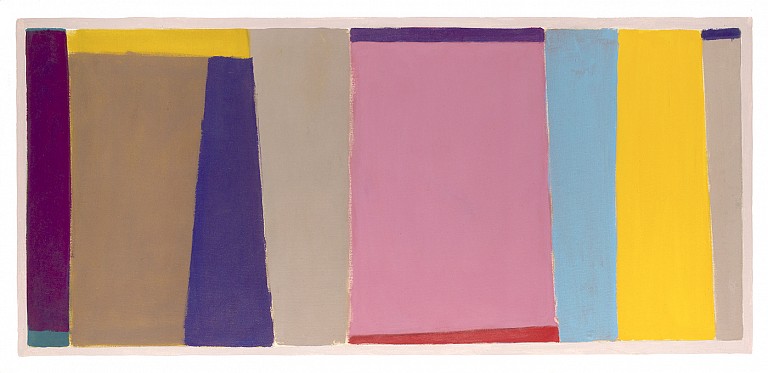
The Permanent Collection: Materiality and Process" Opens at The Parrish Art Museum
December 12, 2016 - Hamptons Art Hub
The Parrish Art Museum has unveiled nine new exhibitions under the umbrella of "Materiality and Process." Presented in the permanent collection galleries, each exhibition explores the process of art making, materials and the presence of the hand of the artist. On view through October 27, 2017, the exhibitions are also designed to highlight art from the Parrish's permanent collection. "Materiality and Process" also highlights significant new acquisitions added to the collection in the last year.
The Parrish's biennial, "Artists Choose Artists," continues on view through January 16, 2017. The annual "Student Exhibition" follows and will be on view from January 28 to February 26, 2017.
"Materiality and Process" is the fifth annual exhibition project that explores a theme developed in art from the Parrish's permanent collection and presented in the museum's permanent galleries. The annual permanant exhibition project also includes significant recent acquisitions, many representing new artists to the Parrish's collection.
Collectively, the exhibition presents 90 paintings, sculptures, mixed-media and works on paper in nine thematic narratives. Taken together, the exhibitions illuminate the ways modern and contemporary artists have embraced creative processes and a variety of materials that move beyond traditional media—such as paint on canvas or charcoal or pencil on paper—to create their art.
“As an overarching theme, the idea of "Materiality and Process" gives the Parrish a great opportunity to mine the collection for excellent examples of the many ways in which artists have embraced a wide range of approaches to art making” stated Parrish Art Museum Director Terrie Sultan in the exhibition announcement..
"Materiality and Process" features several recent acquisitions that introduce renowned artists to the Parrish collection. They include Joe Brainard, Dan Colen, Kim MacConnel, Graham Nickson and Josh Tonsfeldt. In addition, new works such as Portrait of Frank O’Hara by Alex Katz; Ray Johnson’s Untitled, 1965; and two drawings by Billy Sullivan—Max and10/22/91 3:15PM and 3:50PM—expand the museum’s holdings of key artists.
Yearly reinstallations of the permanent collection also provide the Museum with fresh opportunities to reveal works not previously seen in the current facility. "Materiality and Process" includes paintings on view for the first time by Grace Hartigan, Elaine de Kooning, Conrad Marca-Relli, and Syd Solomon.
The overarching theme of "Materiality and Process" is introduced in "Truth to Materials" through art works that reveal the physical process of art making and employ tactile materials. Alfonso Ossorio’s Unsuccessful Tow, is fabricated with horns, eyes, bones, and shells. Louise Nevelson’s Untitled, is composed of intricately cut pieces and found objects that transform the viewer’s perception of what constitutes art.
Further, Josh Tonsfeldt’s sculpture—made up of material that includes alligator hide, wood, acrylic, and glass—encourages viewers to walk around, contemplate, and piece together strategically placed sensual materials designed to evoke memory. Emphasizing material and challenging the idea of a flat picture plane, Al Souza uses thousands of puzzle pieces as both the subject and medium of Cat Hair. Joe Zucker builds up the surface of his painting with cotton balls soaked in paint. Alan Shields deconstructs the very concept of a painting on canvas in Devil, Devil Love, as does Kim MacConnel in Jingle, where unprimed fabric is painted, cut into strips and sewn together.
The exhibition "Collective Conversation" presents five works spanning 50 years that also provide a dramatic exploration of materials as well as architecture, geometry, solid form, and fleeting gesture. These includes art by Dan Flavin, whose work is composed almost entirely of light,; Keith Sonnier and his juxtaposition of solid shapes and fragile neon; Dorothea Rockburne's wall installation combining folded canvas and drawing; a Mel Kendrick's piece that reveals an experimentation with structure and texture through the medium of pulp paper; and a Costantino Nivola’s art work that features his technique of carving an image in wet sand and setting it with poured plaster.
The exhibition "Material Witness" speaks to the sheer physical presence of paint itself and how the artist’s application and use of color creates radiant and dynamic effects. In Blinds and Shades, Josh Dayton literally extends the painted surface by attaching sculptural forms to the canvas, while Herman Cherry and John Opper use color to create paintings that seem to vibrate with energy. Willem de Kooning’s ribbon-like strokes, cascading in swathes of vibrant color, attest to the primacy of the material substance in the evolution of painting. Six of the eight paintings in this exhibition are on view for the first time at the Parrish's Water Mill location.
The exhibition "American Views" presents art spanning nearly 100-years and reveals the process of artists who challenged the conventions of the Hudson River School by reimagining the landscape. Samuel Colman and George Henry Smillie opted for close-up studies of nature; Martin Johnson Heade focused on the effects of light on water; John Henry Twachtman and Childe Hassam applied the French Impressionists’ bright palette and vibrant brushwork to thoroughly American subjects; and April Gornik provides a visceral experience of the landscape with her large scale paintings.
One of the great American modernist painters was Fairfield Porter, and the Parrish is renowned for the depth and breadth of his works in the permanent collection. The exhibition "Fairfield Porter: Friends and Family" presents a fresh look at Porter’s grasp of the very materiality of paint in a series of portraits that hover between straight-on depictions of people and abstract pictorial relationships between color and form.
Using bold gestures in paint, Porter addresses the specific character of people, places, and things as they are—from two matter-of-fact yet tender paintings of the family’s Golden Retriever Bruno, to portraits of his young daughters in the familiar architecture of their home, surrounded by furniture and furnishings that likewise become active members of the scene.
Back to News
